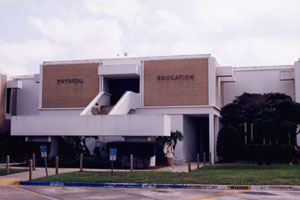 Home
Home- College of Education Buildings
- Physical Education Building 1968-2000


Physical Education Building 1968-2000

The Physical Education building and gymnasium were planned for development on the USF Tampa Campus as early as 1961. However, it was not until the spring semester of 1967 that the building and the gymnasium were officially opened. The facilities housed the Professional Physical Education Department, the Physical Education Department, Campus Recreation and Intramurals Department, and the Athletic Department. Since the buildings were constructed with general funds from the Florida State University System (SUS), the Professional Physical Education Department had first priority of scheduling academic classes, followed by the Physical Education Department, Campus Recreation and Intramurals Department, and then the Athletic Department.
Although there was a growth in personnel in each of the departments over the years, the buildings serviced the four departments until 1998, when Campus Recreation and Intramurals constructed the Campus Recreation Center adjacent to the Physical Education Department’s gymnasium. In 2004, USF Athletics built its new Athletic Complex and moved to its new facility after 35 years of sharing space in the Physical Education building. (See photographs of the Physical Education building and gymnasium.)
In its original plans, the Physical Education building was designed to have six classrooms, 28 offices, and a conference room. It provided a large gymnasium with portable bleachers for basketball, badminton, and other activities. There was also a gymnastic room, a wrestling room, equipment check-out room, and an Olympic-size swimming pool on the second level. The ground level had a dance studio, small weight-training room, athletic training room, exercise physiology lab, and men’s and women’s locker rooms. There was a construction error that provided an interesting feature to the new facilities. A door was inexplicably placed ten feet above the floor of the gymnasium. The door opened out to a sound booth located on the second floor. It was decided that it would be less expensive to keep the door locked than to remove the door and repair the area.
The faculty of the Professional Physical Education Program found that the facilities were barely adequate for their teacher preparation and wellness programs. This was the case because the Physical Education building and gymnasium were often used for athletic team practices, intramural practices, competitions, and fifty physical education activities classes each semester. Despite the lack of an ideal environment, the Professional Physical Education Teacher Preparation Program and the Adapted Physical Education Program were nationally recognized. This was due to an outstanding faculty, an innovative curriculum, and dedicated students.
The Physical Education building continues to be redesigned to accommodate the faculty’s programming in the development of technological innovation in the teaching of physical fitness and wellbeing. In 2006, the College entered into an agreement with iTech Fitness of Denver, CO and XRKade Research Lab was developed under the leadership of Dr. Steve Sanders, Chair of the School of Physical Education, Wellness, & Sport Studies. It is the first university interactive fitness research lab. The fitness lab is designed to investigate the impact of technology-based interactive game activities on children’s physical activities and fitness levels. In the upcoming years, the researchers involved in XRKade may shed light on innovative ways of combating childhood obesity. The XRKade continues to enhance the mission of the College of integrating new innovations in technology to improve the quality of education and overall well-being of school children.










